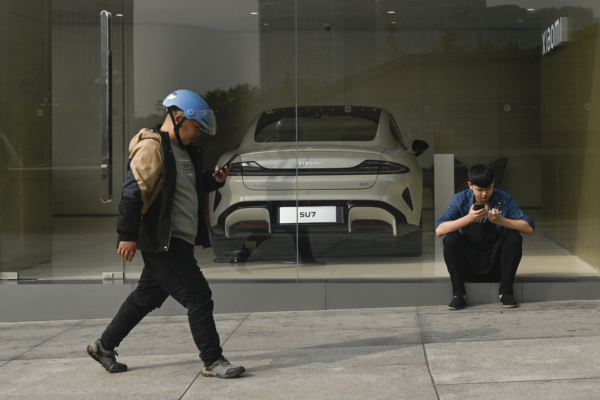Xiaomi SU7’s car accident at the end of March has drawn public attention, and the accident analysis report released by Xiaomi afterwards is considered a way to shift responsibility as part of a public relations operation.
On March 29th around 23:00, a Xiaomi SU7 standard version caught fire after crashing into a guardrail on the Chiqi section of the Deshang Expressway in Tongling, Anhui, resulting in the burning death of three college students inside the car. Following the incident, the victims’ families spoke out on social media, questioning why the Xiaomi SU7 caught fire after the collision and why the car doors were locked and couldn’t be opened.
Three days after the accident on April 1st, Xiaomi Motors issued a statement stating that before the accident, the vehicle was in NOA intelligent driving assistance mode, driving at a speed of 116 km/h; the vehicle detected obstacles, issued a warning, and began to slow down; the driver took control of the vehicle, switched to manual driving mode, continued to decelerate and steer the vehicle, and then collided with a cement post on the barrier. The system confirmed the speed just before the collision to be approximately 97 km/h.
Critics widely believe that Xiaomi’s statement is an attempt to shift blame. Media outlet LT Vision pointed out in a program that Xiaomi revealed the person responsible for the accident without an independent investigation, indicating the statement was subtly shifting blame. They mentioned, “Since you took over after the system detected the fault, and then you crashed, you can’t blame me for not braking.”
Internet user “Knowledge Drifting” posted on ifeng.com, stating that Xiaomi’s statement dodged key facts and downplayed the tragic nature of the incident. The statement only expressed “deep regret” instead of a clear mourning for the deceased, and avoided mentioning core facts like “three deaths” and “car fire.” The timeline presented in the statement was misleading. The user believed that the statement strategically avoided addressing core safety issues.
The article also pointed out that in the statement, Xiaomi emphasized that after NOA was disabled, the accident was attributed to driver error without addressing two key controversies: why the system only gave a one-second warning in a construction road scenario (much lower than human reaction time), and whether the standard SU7 version lacking a lidar system has insufficient reliability in identifying obstacles in complex nighttime lighting conditions.
Moreover, despite Xiaomi’s claim that they established a working group and contacted the families, on April 1st, the mother of one of the deceased, “PoetryRain370491153,” stated on her Weibo account that there had been no contact with Xiaomi company employees.
Simultaneously with Xiaomi’s statement, Xiaomi founder Lei Jun expressed deep sorrow on his Weibo account. He promised that Xiaomi wouldn’t evade responsibility, cooperate with the police investigation, and strive to address the families’ concerns.
Lei Jun’s Weibo post received 19,000 reposts and 42,000 comments, with most comments staunchly defending Lei Jun and criticizing the families of the victims rather than showing sympathy. A Weibo user posted a screenshot on April 2nd, showing numerous repetitive comments praising Xiaomi and targeting the families, which raised suspicions of manipulation and online brigading.
Contrary to the overwhelming comments on Lei Jun’s Weibo post, family members were silenced, with the Weibo posts from the mother of one of the victims related to the accident being deleted. Currently, the families have disappeared from the public eye.
Addressing this phenomenon, Weibo influencer “LiushenLeilei” mentioned that in the wake of the Xiaomi SU7 accident, debates were mainly focused on Lei Jun, whether he should speak up, how he should handle public relations, and whether his actions would be seen as positive or negative. The conversation seemed to overlook the families of the victims, reflecting misplaced priorities.
Another blogger summarized that in the case of accidents involving domestic electric vehicles, a pattern emerges where videos are scrubbed from the internet, blame is shifted to the driver, and a flood of coordinated posts defending the manufacturer flood the online space.
“Knowledge Drifting” also highlighted that Xiaomi’s strategy exposes a common dilemma in the new energy vehicle industry: the disconnect between autonomous driving promotion and taking responsibility – excessively promoting “intelligence” while ignoring system limitations; lack of user-friendly safety design – transferring the cost of emergency functions to consumers; and a misaligned crisis public relations perspective – using data disclosures to mitigate emotional responsibility and overlooking the unique social nature of public safety events.
The article emphasized that when companies draft statements regarding life-and-death matters with a legal mindset, they inevitably lose the moral high ground.
In an odd trend in China, when foreign electric vehicles experience similar accidents, public sentiment is drastically different. In 2016, when Tesla had its first serious accident in China, public opinion was united in condemning Tesla’s autonomous driving system.

